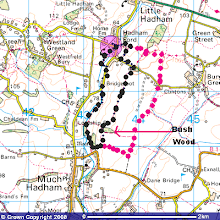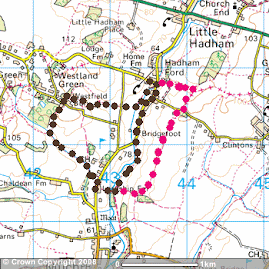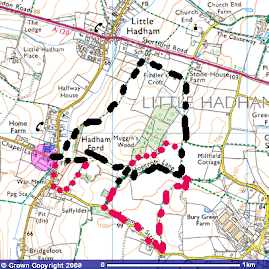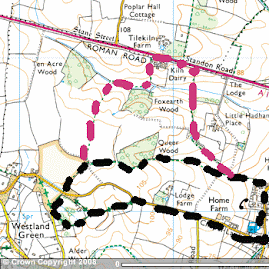A whole day in North Norfolk, leaving home at 5a.m. after the moth trap had been checked. A coffee near Ely, as usual meant I was at Titchwell before 7a.m and the only one on the whole reserve. A slight, light drizzle and north westerly breeze meant I wasn't expecting too much, but this reserve offers so much, there is always something to see and hear.
A check around the car park trees gave up little (a male golden oriole was recorded hear in the late afternoon!) so on to the reserve. Waders galore on the freshmarsh, but before arriving to check these, a wood sandpiper called and flew off north towards the coast, over Thornham grazing marsh. I suspect it rose unseen from the mud and pools on Thornham Marsh. First year lister. The light was not good for checking Freshmarsh etc, so off to the beach. Breezy conditions with a good swell meant hard to view through the scope. Huge numbers of oystercatchers on the beach, along with sanderling and turnstone with several curlew and bar tailed godwits.
 |
| redshank |
 |
| confiding black headed gull: Titchwell beach |
 |
| Superbly plumaged black tailed godwit |
 |
| This redshank was hiding from some ground predator. Very adgitated. |
 |
| Distant bar tailed godwit in early morning light |
 |
| Black tailed skimmer: Titchwell footpath |
 |
| feeding little egret |
Back on the reserve regular fare was noted: reed buntings and linnets over Thornham way, looking towards Holme, skylarks, little egrets and curlews in the ditches and a constant flow of black headed gulls. Into the Parrinder hide and plenty of avocets, black tailed godwits with smaller numbers of bar tailed. In amongst a party of 15 feeding ruff were some dunlin and a solitary curlew sandpiper, showing the fading summer plumage and emergence of the tell tale white supercilium of winter plumage. The white rump showed as an unseen raptor or predator put all waders and terns up. A few sandwich terns and moulting common terns before I headed back for the opening of the moth traps. Having been a breezy and cold night, low expectation of the contents was proved correct, but an old lady and purple thorn were good to see. Another coffee and the Titchwell special bakewell tart had me raring to go. As with my previous trip, I then decided to head east to Cley, check out the Cley square and then just pop into other noted sites.
As I drove along the A149, at reference 835435 an owl sp caught my eye shortly after the sharp left hand bend. I turned as soon as I could, parked and checked the field. Nothing of the suspected barn owl, so back to the car and onwards. After 25 yards, the owl was again seen, now on the right hand side. Fortunately, a parking spot and I was out, firing off many photos. A superb sight, which I enjoyed for half an hour before the presumed 1st year bird disappeared from view. Over 130 photos taken, which was soon reduced to 20 in the car and then even fewer on the laptop!
 |
| Barn Owl from A149 north of Burnham Market |
 |
| Light was tricky as this bird ranged over the field. sadly, a little over exposed....... |
 |
| ..........but it was a very white bird, all the same. Probably 1st year. |
Before Cley I popped down to Stiffkey Greens for a quick scan. A distant spoonbill was added to the list, but nothing else of note, so onwards.
At Cley, a wander along East Bank was worthwhile, with Arnold's Marsh holding over 200 sandwich terns, curlew, cormorant, redshank, avocet but not the 300 whimbrel that some swaro carrying camo clad birder had informed me of as I photographed a rather worn sedge warbler on the east bank by the car park. 300 whimbrel would be incredible, (unheard of, I suspect) but there were several hundred black tailed godwits, so, mis-identification from a new birder, perhaps.
 |
| Good pose |
 |
| Worn sedge warbler with breakfast |
 |
| shelduck and avocet from Daukes, Cley |
 |
| Black tailed godwit, further moulted than that shown at the top. |
 |
| Cley avocet |
From here, after the 3rd coffee of the morning and managing to get away from the book shelves without making a purchase, a side trip, firstly to Kelling Heath, but just a few finches etc on show and then to Sheringham cliffs, but nothing of note during a 20 minute sea watch so back along the A149 to Kelling and a wander to one of my favourite quiet spots on the coast: Kelling Water Meadows. This is always a pleasant walk but little of note in the high hedges before the water meadows. A good site for wood sandpiper, but clearly not today, as there only were plenty of black headed gulls and a few of the now dangerous and infamous attack gulls formerly known as herring gulls. I left unscathed!
Stiffkey Fen was next on the agenda, another quiet and relatively unbirded site. Here, a moulting med gull made the day list and waders such as godwits and avocets were noted. Teal, gadwall, mallard were evident and several egrets and a grey heron. The latter having issues with a family of greylags. A scope scan of Blakeney harbour offered little, so a return to Cley for an afternoon sea watch and, if time permitted, a quick visit to Daukes Hide on the reserve.
Nothing on the sea, so off to the hides. a green sandpiper from Daukes, briefly and a little ringed plover made the day list as I scanned through endless ruff and godwits for any unusual waders. There were none, so a slow wander back to the car. The light had not been good for most of the afternoon, with a couple of light rainfalls, but nothing as predicted on the met office weather forecast on Radio 4 earlier in the day. Strange these forecasts, as the BBC website, as viewed on Monday evening, was spot on for Wednesday whilst the morning forecast for that day, on the BBC was clearly not correct!
Off to Wells to meet Gary in The Edinburgh for a couple of jars before heading home. Good to catch up again with Gary, but due to tiredness, increasing old age and basic forgetfulness, I bought 2 pints and promptly forgot to pick up my wallet from the bar. This error was not noted until I arrived home, a few hours later and a phone call to The Edinburgh informed me that they could not find it. Consequently, cancelled bank cards, £50 lost and more importantly, a few old photos and driving licence, the latter which of course can be replaced. Silly sod!!
All in all, apart from my error at the end of the day, a great day out and a pleasing set of photos. Strange how sometimes you get a good set, whilst for no apparent reason, you return on occasions with a poor and disappointing set that really are not worth putting here.
Species list;
cormorant, little egret, grey heron, spoonbill, mute swan, greylag goose, canada goose, shelduck, mallard, gadwall, (10 sp) shoveler, teal, tufted duck, red kite, marsh harrier, common buzzard, kestrel, red legged partridge, pheasant, moorhen (20 sp) coot, oystercatcher, avocet, little ringed plover, grey plover, lapwing, sanderling, turnstone, dunlin, curlew sandpiper (30 sp) wood sandpiper, green sandpiper, common sandpiper, redshank, black tailed godwit, bar tailed godwit, curlew, ruff, black headed gull, mediterranean gull,(40 sp) herring gull, lesser black backed gull, greater black backed gull, sandwich tern, common tern, stock dove, wood pigeon, collared dove, barn owl, little owl (50 sp) green woodpecker, skylark, sand martin, swallow, house martin, meadow pipit, pied wagtail, wren, dunnock, robin, (60 sp) song thrush, blackbird, chiffchaff, reed warbler, cetti's warbler, sedge warbler, great tit, blue tit, long tailed tit, magpie (70 sp) jay, jackdaw, rook, carrion crow, starling, house sparrow, chaffinch, goldfinch, greenfinch, linnet (80 sp) reed bunting.
























































